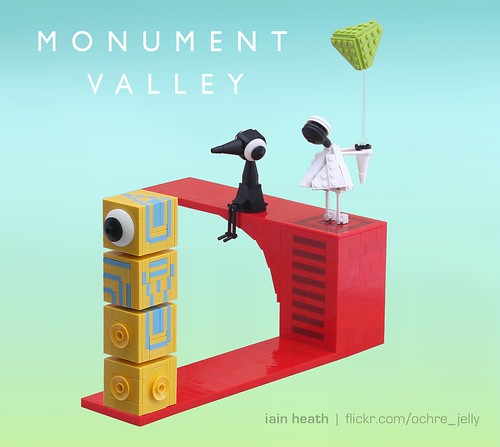
Showing posts with label optics. Show all posts
Showing posts with label optics. Show all posts
Saturday, December 20, 2014
Monument Valley
Iain Heath made this from Monument Valley, a game that uses a lot of Escher-esque scenes and impossible objects, such as this based on the Penrose triangle I've discussed here before.


Friday, July 19, 2013
Working microscope
Carl Merrian built this Working microscope. It uses official LEGO elements like the magnifying glass element, technic gears, and fiber optic system to actually allow you to focus in on small objects.


Monday, January 14, 2013
Microscope
Gilcélio Chagas built this great microscope. Rather than give my own explanation, I'll just quote his:

A microscope (from the Ancient Greek: μικρός, mikrós, "small" and σκοπεῖν, skopeîn, "to look" or "see") is an instrument used to see objects that are too small for the naked eye. The science of investigating small objects using such an instrument is called microscopy. Microscopic means invisible to the eye unless aided by a microscope. There are many types of microscopes, the most common and first to be invented is the optical microscope which uses light to image the sample. Other major types of microscopes are the electron microscope (both the transmission electron microscope and the scanning electron microscope) and the various types of scanning probe microscope. The first microscope to be developed was the optical microscope, although the original inventor is not easy to identify. An early microscope was made in 1590 in Middelburg, Netherlands.Two eyeglass makers are variously given credit: Hans Lippershey (who developed an early telescope) and Zacharias Janssen. Giovanni Faber coined the name microscope for Galileo Galilei's compound microscope in 1625 (Galileo had called it the "occhiolino" or "little eye").

Thursday, June 14, 2012
Impossible objects explained
I occasionally draw something like this on the board and ask my students what it is:

When they reply 'a cube' I correct them, saying that it is a two dimensional drawing that uses tricks of perspective that our mind interprets as a three dimensional cube. Two dimensional drawings of impossible objects take advantage of these tricks of perspective, but the tricks don't match up. So if you cover up one part of the drawing and then cover up the other part of the drawing, different sections appear to be going in different directions. For example, take the famous devil's fork:

If you cover up the right-hand portion, you see three prongs, but if you cover the left portion you see two prongs. However, the lines connect up so at some point the three become two, or the foreground becomes the background. But how to achieve this in three dimensions? The whole idea of an impossible object is that it is impossible. The answer, of course, is that you can only see these from one particular point of view. If you were to look at them from any other angle, you would see that the edges don't match up. For instance ...
Brixe63's Terrace.
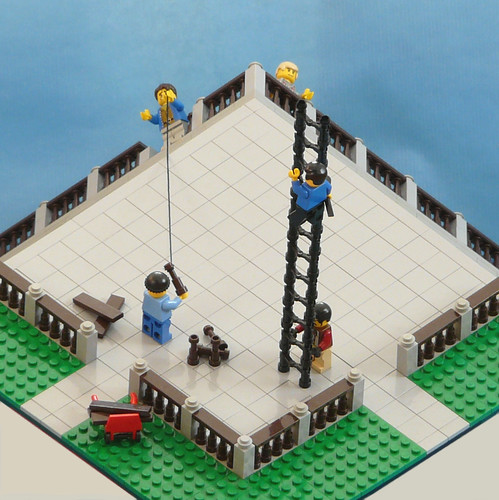

Legohaulic's Nightmare.
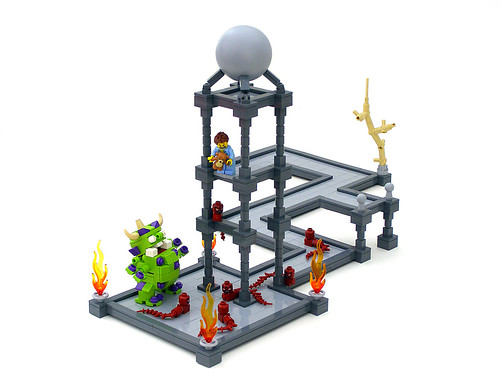
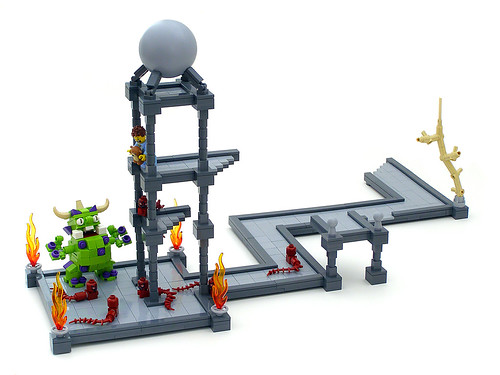
Henry Lim's Ascending and Descending.


Andrew Lipson and Daniel Shiu's Belvedere.



When they reply 'a cube' I correct them, saying that it is a two dimensional drawing that uses tricks of perspective that our mind interprets as a three dimensional cube. Two dimensional drawings of impossible objects take advantage of these tricks of perspective, but the tricks don't match up. So if you cover up one part of the drawing and then cover up the other part of the drawing, different sections appear to be going in different directions. For example, take the famous devil's fork:

If you cover up the right-hand portion, you see three prongs, but if you cover the left portion you see two prongs. However, the lines connect up so at some point the three become two, or the foreground becomes the background. But how to achieve this in three dimensions? The whole idea of an impossible object is that it is impossible. The answer, of course, is that you can only see these from one particular point of view. If you were to look at them from any other angle, you would see that the edges don't match up. For instance ...
Brixe63's Terrace.


Legohaulic's Nightmare.


Henry Lim's Ascending and Descending.


Andrew Lipson and Daniel Shiu's Belvedere.


Wednesday, June 13, 2012
Impossible objects
Several of the Escher illustrations depicted over the past few days are impossible objects - two dimensional drawings that seem to be of three dimensional objects, but turn out to be optical illusions, unbuild-able in real life. One of the first impossible objects, and one of the inspirations for Escher's Waterfall and other works, is known as the Penrose triangle. This was actually first depicted by Oscar Reutersvärd in 1934, before Roger Penrose independently presented his version.
The Penrose Triangle was the basis for the Lugnet logo. Lugnet was one of the first major LEGO websites.

John Langrish made this mosaic of the Lugnet Logo.

The Penrose Triangle has been recreated in LEGO many times. Some of these depend on Photoshop trickery, but others are true three-dimensional creaions, such as this by Billy Baldwin.

Brixe63's Modulex version is more remniscent of Reutersvärd's original design.
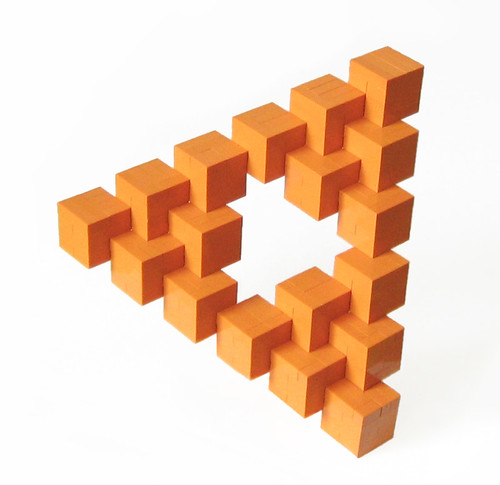
Various other LEGO impossible objects have been built, such as Don Solo's archway.

Brixe63 has had great fun with the idea in her set of optical illusions.
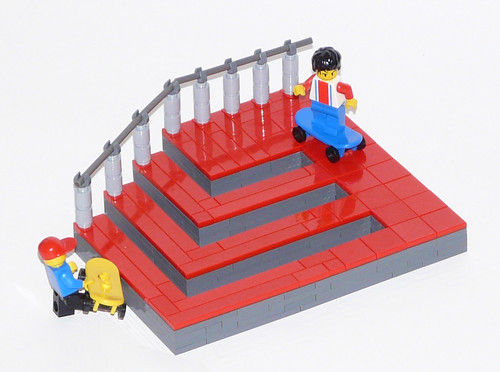
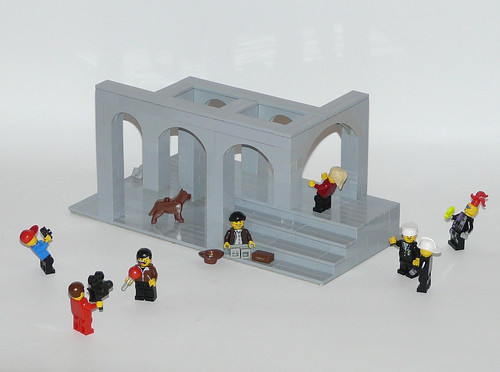
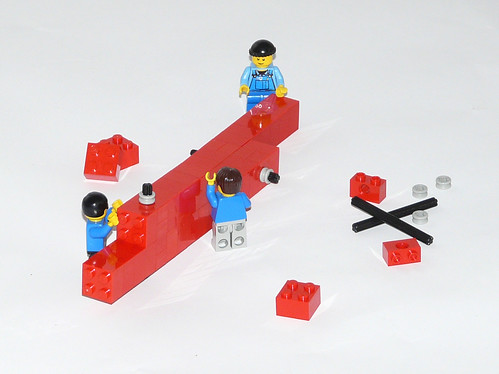
Brixe63 also has this amazing Terrace, that is based on an impossible scene that was apparently first used by Sandro del Prete (who was influenced by Escher).

The Penrose Triangle was the basis for the Lugnet logo. Lugnet was one of the first major LEGO websites.

John Langrish made this mosaic of the Lugnet Logo.

The Penrose Triangle has been recreated in LEGO many times. Some of these depend on Photoshop trickery, but others are true three-dimensional creaions, such as this by Billy Baldwin.

Brixe63's Modulex version is more remniscent of Reutersvärd's original design.

Various other LEGO impossible objects have been built, such as Don Solo's archway.

Brixe63 has had great fun with the idea in her set of optical illusions.



Brixe63 also has this amazing Terrace, that is based on an impossible scene that was apparently first used by Sandro del Prete (who was influenced by Escher).

Sunday, June 10, 2012
Escher: Belvedere
Belvedere has been another subject for LEGO Escher fans.
Andrew Lipson and Daniel Shiu.

Henry Lim.

Jung von Matt ad agency.

Brixe63, who has done a number of optical illusions, made some Belvedere-inspired bunk beds.

Andrew Lipson and Daniel Shiu.

Henry Lim.

Jung von Matt ad agency.

Brixe63, who has done a number of optical illusions, made some Belvedere-inspired bunk beds.

Thursday, April 5, 2012
Zoetrope
I've previously noted how a zoetrope uses a series of still pictures to trick your brain into seeing movement - essentially the same thing that happens in a movie projector. Here is a zoetrope of a galloping horse by Lego Tron. The galloping horse is a particularly appropriate subject (as Lego Tron notes), because it hearkens back to the work of Eadweard Muybridge. Muybridge was a photographer who was interested in seeing how animals move. In a famous experiment, he set up a series of cameras along a racetrack that were triggered to snap photos as a horse galloped past. These pictures could be strung together in an early version of a motion picture, similar to the zoetrope, called a zoopraxiscope. These pictures also proved that at points during the gallop, all four feet were in the air at once. BTW, I first learned about the Muybridge work after Ahmed Zewail won the 1999 Nobel Prize in Chemistry, since he compared his work to Muybridge. Zewail used extremely short (femtosecond) bursts of laser light to "photograph" a reaction in motion, and actually characterize something at (or very near) the transition state. In comparison to the Muybridge work, this is like being able to sit and study the horse with all four feet in the air. Of course you normally can't do that, since the horse would fall to the ground, but you can study the photograph that captures that moment in time. A transition state (which is a point in the reaction path where some bonds from the starting material are breaking and other bonds from the product are being formed) can normally not be observed, since it is so instantaneous, but Zewail gave us a peek behind that curtain.


Tuesday, December 20, 2011
Friday, September 23, 2011
Zoetrope
A zoetrope is a device to create an optical illusion of movement out of still pictures. A cylinder is set vertically so it can spin. Along the inside are individual pictures, and the cylinder walls are pierced by slits. As the cylinder spins, your eye catches glimpses of the pictures inside in quick succession, and your brain strings these together into a moving image. The early predecessors of the zoetrope go back almost a couple of millenia, but the modern zoetrope was invented about two centuries ago. Improvement and related devices led over the course of the 1800s led to the motion picture projector, and today's movie theaters, which work on pretty much the same principle. This LEGO zoetrope by 62bricks was inspired by an earlier creation by Lego Tron.
Subscribe to:
Posts (Atom)
